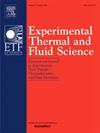Effect of hydrogen concentration, vented area, and vented shape on vented hydrogen-air explosions and its consequence analysis
IF 3.3
2区 工程技术
Q2 ENGINEERING, MECHANICAL
Experimental Thermal and Fluid Science
Pub Date : 2025-04-04
DOI:10.1016/j.expthermflusci.2025.111484
引用次数: 0
Abstract
As the infrastructure for piped hydrogen, including long tube trailers, urban utility tunnels, and hydrogen fuel cell vehicles, expands, the risk of hydrogen explosions increases. To enhance safety technologies and minimize accident risks, this paper presents a study where hydrogen venting tests were conducted with concentrations ranging from 30 % to 60 % in a 2.25-meter-long shock tube with an inner diameter of 70 mm. The effects of different vented areas and different vented shapes on the overpressure propagation law and flame characteristics were investigated. The results indicated that higher hydrogen concentrations increase vent flame temperature, but not pressure proportionally, with 40 % H2 producing the highest pressure peaks under all vented conditions. Smaller vented areas reduce the secondary explosion's impact on internal piping and the sensitivity of venting effectiveness to concentration. The distribution of pressure peaks on the outside of the pipe is highly dependent on the vented area. The vented shape has little effect on pressure, but has a slight effect on flame characteristics at R=2/5 or 1/5. In addition, the mechanism behind pressure peak generation during pipeline venting and a brief consequence analysis of the most hazardous scenario of secondary explosions has been provided.
氢气浓度、通风口面积、通风口形状对氢气空气通气爆炸的影响及后果分析
随着管道氢气的基础设施(包括长管拖车、城市公用隧道和氢燃料电池汽车)的扩大,氢气爆炸的风险也在增加。为了提高安全技术,最大限度地降低事故风险,本文介绍了一项研究,在2.25米长、内径70毫米的激波管中进行了浓度为30%至60%的氢气排放试验。研究了不同通风口面积和不同通风口形状对超压传播规律和火焰特性的影响。结果表明,氢气浓度越高,火焰温度升高,但压力升高不成比例,在所有排气条件下,40% H2产生的压力峰值最高。较小的通风面积减少了二次爆炸对内部管道的影响,降低了通风效果对浓度的敏感性。压力峰在管道外部的分布高度依赖于排气面积。排气孔形状对压力影响不大,但在R=2/5或1/5时对火焰特性影响较小。此外,还对管道排气压力峰值产生的机理和二次爆炸最危险情景的后果进行了简要分析。
本文章由计算机程序翻译,如有差异,请以英文原文为准。
求助全文
约1分钟内获得全文
求助全文
来源期刊

Experimental Thermal and Fluid Science
工程技术-工程:机械
CiteScore
6.70
自引率
3.10%
发文量
159
审稿时长
34 days
期刊介绍:
Experimental Thermal and Fluid Science provides a forum for research emphasizing experimental work that enhances fundamental understanding of heat transfer, thermodynamics, and fluid mechanics. In addition to the principal areas of research, the journal covers research results in related fields, including combined heat and mass transfer, flows with phase transition, micro- and nano-scale systems, multiphase flow, combustion, radiative transfer, porous media, cryogenics, turbulence, and novel experimental techniques.
 求助内容:
求助内容: 应助结果提醒方式:
应助结果提醒方式:


